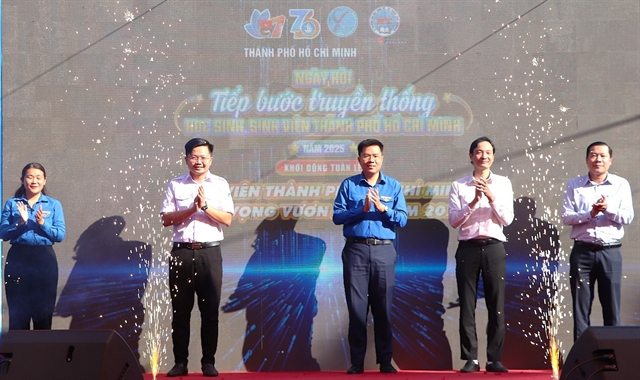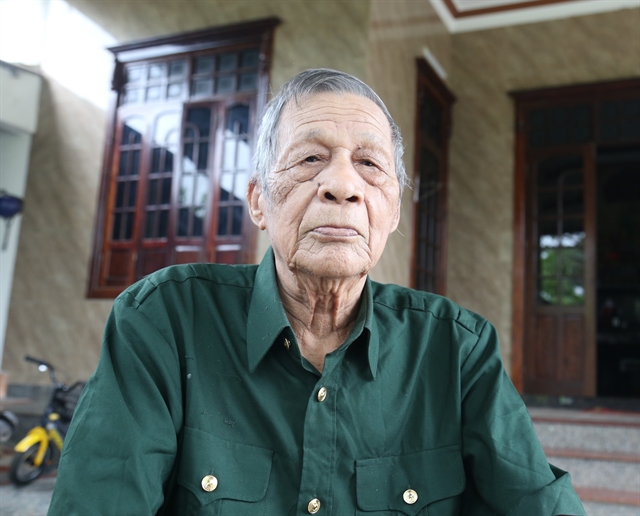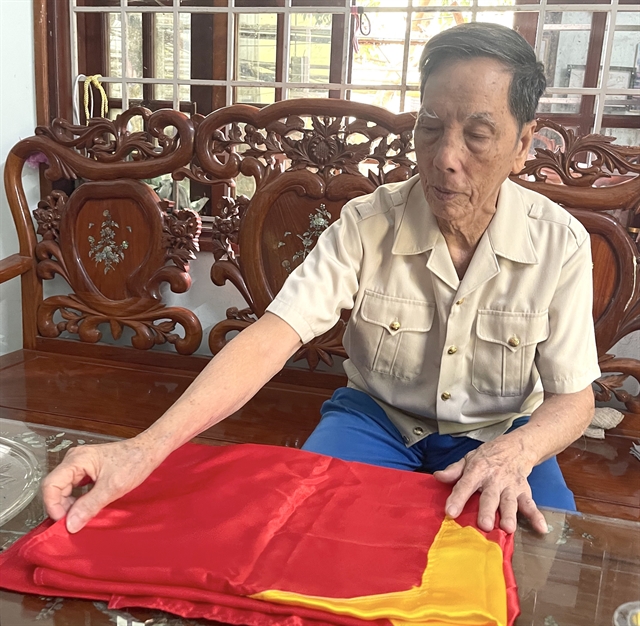 Society
Society

 |
| Nguyễn Văn Trợ, former militia force leader of the Hiền Lương Platoon, participated in protecting bridges, flagpoles and patrolling along the Bến Hải River. — VNA/VNS Photo Thanh Thuỷ |
QUẢNG TRỊ — During the years when Việt Nam was temporarily divided, the Bến Hải River and Hiền Lương Bridge were not only geographical boundaries, but also symbols of the struggle for the sacred aspiration for nation unification.
The place has engraved its name in history over the years, with ordinary people contributing to the silent epic which has become a symbol for a whole generation living and devoting all their love for the country and belief in a unified in following years.
‘Wars’ without gunfire
For Nguyễn Văn Trợ, 89, lives in Hiền Thành Commune, Vĩnh Linh District, memories about the days of living and fighting by the Hiền Lương Bridge are still vivid.
In 1954, after the Geneva Agreement was signed, the Bến Hải River and Hiền Lương Bridge were chosen as the temporary border and Trợ was then the militia force leader of the Hiền Lương Platoon.
During the day, he and everyone else worked as normal but at night, he coordinated with the Hiền Lương police force to protect the bridge, flagpole and patrol along the river.
Recalling this historical period, Trợ said that at that time, the propaganda war was equally fierce, with political struggles, fights over the loudspeakers and battles over the flag.
Few people could imagine that the paint colour of Hiền Lương Bridge was also once the topic of agressive struggles.
“We wanted to paint the entire bridge blue, a symbol of peace and the desire for unification. But the enermy’s side continuously repainted their half of the bridge in a different colour,” said Trợ.
Every time the bridge was divided into two contrasting colours, the Vietnamese army and people immediately repainted it back to a single colour, as a steadfast message of the aspiration for a united country.
Not stopping there, on the northern bank, a large loudspeaker system was set up, broadcasting the voice of the Government, of the people, of the aspirations for peace. Music, drama and revolutionary songs echoed across the southern bank, penetrating deep into people's hearts.
The enemy’s side also quickly set up a larger loudspeaker system, broadcasting distortions and misrepresentations of the truth and so a ‘war of sound’ was fought for a very long time.
But among those countless battles, ‘flag fighting’ is considered the most sacred.
The red flag with yellow star flying on the top of the flagpole on the northern bank was not only a symbol of the Fatherland, but also flew as a message to the people of the South.
Every time, the flagpole was bombed or the flag was ripped apart by the explosions, the militia immediately put it back up.
Bamboo and casuarina trees were found, carried back and erected as flag poles amid the storm of bullets.
In 1962, the Government asked to build a special flagpole, 38.6m high, weighing 15kg, raising a 134sq.m flag, becoming the tallest flagpole on the border.
During the fierce war years, when Hiền Lương was the front line facing ‘rains of bombs and storms of bullets’, Trợ, along with his comrades and the people, did not fear danger.
They were willing to sacrifice their lives to preserve the flag, every inch of land, every tree branch with all their will and patriotism until the day the country was reunited.
Flag makers at the border
 |
| Nguyễn Đức Lãng spent 13 years diligently sewing the national flags to fly on the Hiền Lương flagpole. — VNA/VNS Photo Thanh Thuỷ |
For the people in Quảng Trị Province, no one can forget the image of a soldier who spent 13 years diligently sewing the national flags to fly on the Hiền Lương flagpole.
He is Nguyễn Đức Lãng, 88, currently living in Ward 5, Đông Hà City.
In 1959, he joined the army and became a logistics assistant in the Logistics Division of the Vĩnh Linh District Border Police.
From 1960, he was in charge of military uniforms – a seemingly simple task, but one that was extremely special and sacred – that is, sewing the national flag to fly on the Hiền Lương flagpole and along the route from Hiền Lương to Hướng Lập Commune, Hướng Hoá District.
At that time, the red flag with yellow star was not just an emblem of a nation, but a strong declaration of justice, a burning desire for independence and unification, demonstrating the steadfast will of the North towards the South.
Recalling those unforgettable years, Lãng said, his voice thick with emotion: “At first, without experience, it took me seven days to sew a large flag measuring 96sq.m. Later, when I got used to it, I got faster and I could do one in two and a half days.”
To make such a flag, it took 122sq.m of red fabric and 10sq.m of yellow fabric.
“The most difficult period was April 1965-1970, when the war was fierce, with bombs and bullets raining down day and night. We had to evacuate, hide in the shelter to sew flags. In times of shortage, every metre of fabric was as precious as blood. From measuring, cutting to sewing, everything had to be carefully calculated to avoid even a small loss,” said Lãng.
The most difficult part was assembling the five-pointed yellow star, each five metres long, which had to be spread out on the ground while the shelter was cramped.
“Sitting hunched in the dust, stretching each piece of fabric, threading each stitch, at that time the aspiration and dream of a peaceful tomorrow, a united nation, was always full in my heart. The national flags of that time were not just fabric, but spirit, flesh and blood and the image of a resilient nation,” said Lãng.
The flags Lãng sewed fluttered proudly amid the fire of war, shining brightly on the Hiền Lương flagpole.
That image still lives forever in the nation's memory as a part of the sacred soul of the country.
Today, returning to daily life, he is still happy to sew national flags to hang on important occasions such as Independence Day September 2, National Reunification Day April 30 and for the Lunar New Year.
For his silent but extremely great contributions, Lãng was awarded by the State the First Class Resistance Medal, the Liberation Soldier Medal (First, Second, Third Class) and the Glorious Soldier Medal (First, Second, Third Class).
Major General Hồ Thanh Tự, chairman of the Quảng Trị Province Veterans Association, said that Trợ and Lãng were shining examples of individuals who contributed significantly to the historic victory of the nation in the resistance war.
With the war over for half a century, their contributions still retain their value.
“Each person has a different position and task, but they all have made silent and persistent contributions to the victory,” he said.
During the resistance war, Quảng Trị Province had over 20,000 veterans who served in the fighting, devoted to the cause of national liberation.
Many of them have become historical figures, writing the heroic epic of the nation on many fronts, from politics and the battles of the military, to logistics and culture.
In today's peaceful life, the soldiers continue to play their role in the new era of building, protecting and developing the homeland, as well as educating the younger generation. — VNS




